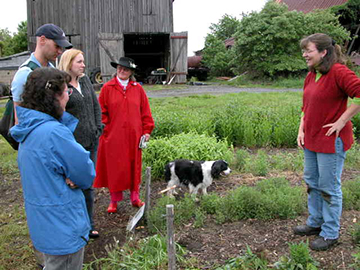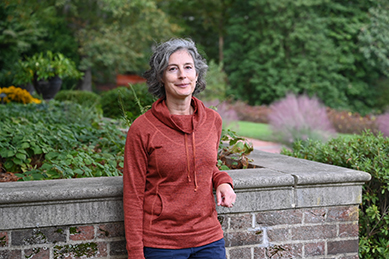What’s really indigenous to a place? We’re talking native plants here. (And ultimately: does native really matter?). OK, first, what’s native?
“If it’s from Asia or South America, it’s not native,” says entomologist Dr. Doug Tallamy, author of Bringing Nature Home. Lonicera japonica or Miscanthus sinensis tell you by their names that they are not from the Delmarva Peninsula. (It won’t necessarily tell you whether it’s invasive, but that’s a different question).
Human beings have always been about “Oooo! New and shiny!” Our peripatetic species has been hauling botanical specimens home for millenniums to add to our gardens, pharmacies, and tables. Thirty-five hundred years ago, Queen Hatshepsut of Egypt dispatched plant hunters to search for a little something new for the royal gardens. Her plant squad dug, balled, and lugged home 32 incense trees. Tulips from Turkey, potatoes from Peru. We’ve had several thousand years of globalization, so what constitutes ‘been here’ versus ‘come here’ is not always a simple question to answer.
The USDA defines native plants as those that “are the indigenous terrestrial and aquatic species that have evolved and occur naturally in a particular region, ecosystem, and habitat. Species native to North America are generally recognized as those occurring on the continent prior to European settlement. They represent a number of different life forms, including conifer trees, hardwood trees and shrubs, grasses, forbs, and others.”
To determine indigenous North American species, many in the US look to the plant catalogues compiled by 18th century Philadelphia botanists John Bartram and his son, William. Lewis and Clarke added to those lists during their years-long exploration of the continent following the Louisiana Purchase in 1803.
It’s a big country, and there are lots of species native to big chunks of it. For example, the white oak (Quercus alba), Maryland’s state tree, is native from Minnesota and Maine to Texas and northern Florida. But will a white oak seedling whose ancestry is in Sheboygan thrive in St Michaels?
“It’s not just: is the plant native to North America?” says Lois deVries, founder of The Sustainable Gardening Institute and The Sustainable Gardening Library, “but: is it suitable for your ecoregion?”
“What’s most important is matching the ecotype provenance,” agrees Tallamy. “It’s native to your region because it’s adapted to your region.”
Years ago, during a drought, Dr Sara Tangren, founder of Chesapeake Natives Nursery (now Coordinator for National Capital Partnership for Regional Invasive Species Management), noticed the striking difference in ecotypes of the same North American Aster species in her nursery.
“The ones from New England struggled but the ecotypes from here in Maryland were thriving on only the morning dew,” she noted. “That’s ecoregion adaption at work.”
Maryland is blessed with a variety of ecoregions that include several different soil types, which also (obviously) affect the plant colonies that have developed. De Vries, who lives in New Jersey, sees this distinction daily.
“The Great Limestone Valley is right across the street from me,” she says. “That’s a very limey gravely area, and very different plants thrive in that. I’m on Martinsburg shale here, which is very different acid soil with completely different plants.”
But if we’re only looking at plants and soil, we miss the additional connection of animals who are dependent on specific native plants, (we’re talking food web), which is a big reason why native plants as the foundation of the food web matter a lot.
“Some of it is based on the lens we are looking through,” says Leslie Cario, Director of Horticulture and Natural Lands at
Adkins Arboretum. Adkins has long been focused on native plants,yet it’s always been in conjunction with the whole ecology of the area. “The people from The Biodiversity Project came out to catalogue what’s here, so it wasn’t just plants; it was insects, and different types of animals. So, it also depends if you’re focusing on conservation or restoration or gardening.”
For Tallamy, who has long promoted the increased use of native plants as a means of restoring shattered biodiversity, it’s ultimately about a plant’s function in a whole community. White oak, for example, supports about 400 different animal species, a huge return on investment (to say nothing of how beautiful they are). So, ‘native’ has to do with a kind of ongoing reciprocity.
“A plant is native when it shares an ecological history with the plants and animals around it,” Tallamy says. “Native plants function better with the things they co-evolved with. It’s how it functions in the environment.”
But it doesn’t mean that all come-here’s are anathema. Come-here’s, when they contribute to the whole, (rather than take over as invasives) are welcome.
“Some people are really strict [about only natives],” notes Tallamy, who is more interested in collective citizenship than in purity. “I have wood poppies in our yard. They are not strictly native to southeast Pennsylvania, but they function as a native. The deer love them.”
So, it’s complicated. And yes, ultimately, native plants matter enormously. They are vital components of a resilient, healthy (and beautiful) food web, landscape, home, and garden. Some may feel as though native plants restrict their garden choices, but Cario suggests that different individual aesthetic visions can easily dovetail with increasing native plant communities since it also enlarges the total gardening experience.
“Consider your gardening an act of altruism,” she says. “So, we’re not just doing it for ourselves, but to support wildlife around us. Even starting small will make some difference, so people should just try something and replace over time as they find out what works for them and what they enjoy. And I think people, who are looking, will enjoy as much the things coming to visit their garden as they are enjoying their garden.”
Resources:
Sustainable Gardening Institute
Maryland Native Plant Society
https://www.mdflora.org/plant-id
https://www.mdflora.org/chapters
Leas photo: Bees on aster.






Write a Letter to the Editor on this Article
We encourage readers to offer their point of view on this article by submitting the following form. Editing is sometimes necessary and is done at the discretion of the editorial staff.